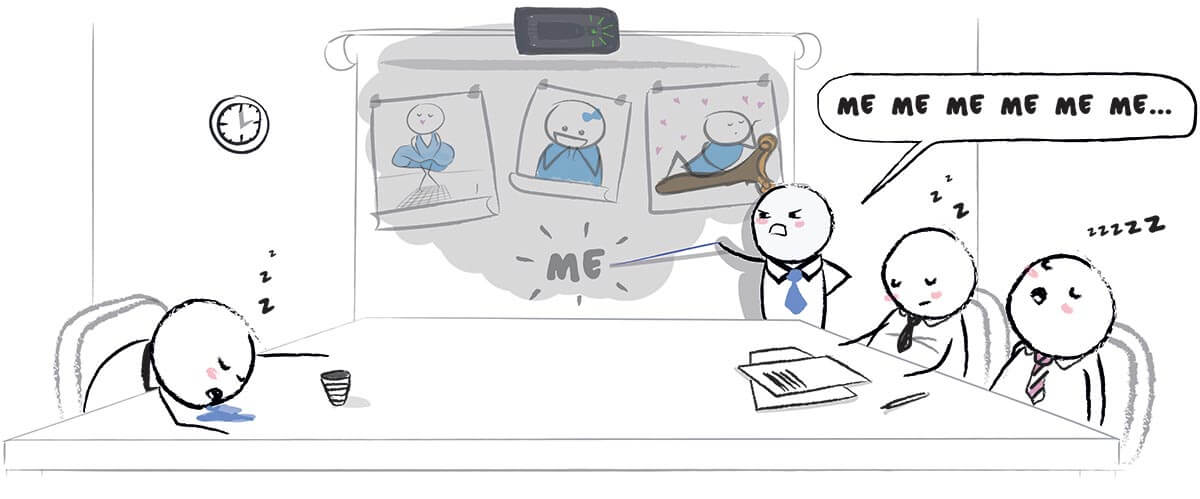Maybe it isn’t what you want to hear, but business creds are often done badly. Numerous, and perhaps harsh, assessments have begun surfacing ranging from ‘They’re all as bad as each other’, by Stephen Fair of Econsultancy, to ‘Most ad agency new business presentations stink. Period’, by Mike Fromowitz, who writes for Campaign.
Harsh, yes, but more often than not, correct.
But it’s something of a catch-22. If you don’t share your creds with a prospect, that prospect won’t know about all the great work you’ve done in the past. There’s also the argument that your creds represent what you do, so why wouldn’t you want to share them? So they are necessary – but if they’re going to stay, perhaps they need a bit of a makeover to hit the right buttons.
Above all else – the trick to great creds is to keep it simple. These are just a few of the tips we apply to turn creds from sleep-inducing to action-making.
Doing your homework
A staple of the JPC process is our 360-degree immersion phase. Before we undertake any project in earnest, we’ll learn everything we can about our client and then some, to arm us with all the necessary information to do our best work. It’s no different with creds. Before you start cobbling together a presentation, take a moment, or several, to consider your client. Look at their business, immerse yourself in their company culture and get a feel for what they value most and the types of characteristics and support they’d want to see from their potential partner or supplier. Then tighten it down from here. Seems obvious? You’d surprised how many forget this first crucial step.

Keeping it real
Of all the many metaphors used to describe a creds presentation, perhaps the most false is the job interview. There are plenty of similarities, and both require authenticity. But authenticity is a much talked about and bandied about phrase. What do we really mean? We mean being ‘authentic’ in different ways, and to varying degrees. In a job interview, you’re required to present yourself in the best possible light, even if that light isn’t entirely accurate. Indeed, in many cases the potential employer will be on the lookout to see who can spin the best story, even if it isn’t true, just to see who’s mastered the art. But with a creds presentation, this approach won’t get you very far. You’re duty-bound to display a 100% clear picture of your business and its capabilities. Anything short of this leads to areas of confusion and obscurity that’ll come back to haunt you down the line, should your prospect choose you. This doesn’t mean you have to air your dirty laundry and point out your weak spots, but showing how you have evolved and dealt with challenges that didn’t perhaps follow the path you first envisaged, will reveal a lot more of the real personality behind your brand.
The all-important 70/30
We try to follow an 70/30 rule when delivering a creds pres, i.e. 70% story, company values and business ethos, and 30% appropriate tactical adjustment depending on the client. Now, this doesn’t mean 70% of your pitch is boilerplate and reusable. That 70% is your business in a nutshell. It has to reflect everything that sets you apart, be delivered articulately, and be compelling and consistent enough to pique the interest of your audience. It’s subject to change just the same as your company, and will require constant attention as your business organically evolves. As for the 30%, this is where your earlier homework plays its part. Once you’ve got a genuine understanding of your client you can flesh out your story with only the most relevant creds, which are sure to hold their focus and speak to their specific requirements, rather than zapping them with the generic whitewash that leaves them looking for the ‘so what?’

What’s in it for them?
The key here is to consistently ask the question: what is the client getting out of this? Once you’ve formulated your 70/30 ratio – look at the common thread throughout your pitch that specifically informs a core benefit, or set of benefits, that your audience can begin considering in earnest after you’ve flicked past the last slide. What is your presentation actually delivering in terms of tangible outcomes for the client? Is this linked to your USPs and what you’re known for as a business? Do your creds evidence this? Ask yourself these questions and be prepared with the answers to avoid having your audience go down a similar line of inquiry come pitch time. Rather than just reeling off a list longer than your arm of your ‘greatest hits’ and supposing your audience will somehow know the subtext, make the key offering you’re bringing to the table a constant throughout your creds and the main thrust behind your presentation.
Looking beyond the 15 minutes
Your creds pitch doesn’t start when you point to your first slide. It doesn’t even start once you’ve sat down with your customer. It starts at the very moment you open the door. Of course, it’s your presentation itself that’ll make the decisive impact, but don’t underestimate the importance of the small details. Everything from the handshake, to the small-talk in the build up, to the subsequent chatter once all is said and done can often say more about you and your company than the most captivating creds imaginable. Again – by properly doing your homework, taking the time to really understand your customer and making these moments add up to a true reflection of your business values can make a big contribution to the impact of your pitch.
The consistent chameleon
There’s a lot more to consider when pitching your creds, and of course it changes from presentation to presentation. At JPC, our creds pitch is an organic entity that learns and evolves each time it’s called in for duty. That’s part and parcel of the landscape we live in – client criterias change, business trends shift faster than ever before and new factors are introduced. One thing that will always stay the same, though, is the point behind creds: revealing your true identity in a way that resonates with your audience. I like to call it the consistent chameleon.


